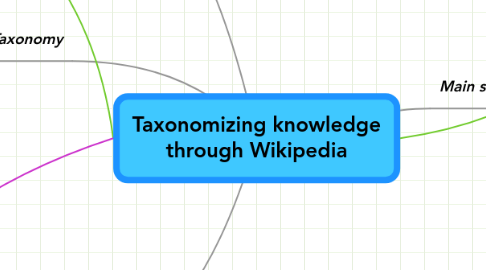
1. Knowledge engineering
1.1. Knowledge representation
2. Knowledge representation
2.1. A
2.1.1. Argument mapping
2.2. C
2.2.1. Classification systems
2.3. G
2.3.1. Grouping
2.4. K
2.4.1. Knowledge bases
2.4.2. Knowledge discovery in databases
2.4.3. Knowledge representation languages
2.5. M
2.5.1. Mereology
2.5.2. Micromorfats
2.5.3. Minimum Information Standards
2.5.4. Multi-agent systems
2.6. O
2.6.1. Ontology (information science)
2.7. S
2.7.1. Semantic desktop
2.7.2. Semantic Web
2.7.3. Strategy
2.8. T
2.8.1. Taxonomy
3. Taxonomy
3.1. C
3.1.1. Controversial taxa
3.2. F
3.2.1. Folksonomy
3.3. G
3.3.1. Georagphic taxonomies
3.4. O
3.4.1. Taxonomy organizations
3.5. P
3.5.1. Plant taxonomy
3.6. S
3.6.1. Scientific classification
3.7. T
3.7.1. Taxon authorities
3.7.2. Taxonomic categories
3.7.3. Taxonomists
3.7.4. Taxonomy disambiguation pages
4. Main subcategories
4.1. A
4.1.1. Academia
4.1.2. Applied disciplines
4.2. B
4.2.1. Bodies of knowledge
4.3. C
4.3.1. Consulting
4.4. D
4.4.1. Knowledge deities
4.5. E
4.5.1. Education
4.5.2. Knowledge engineering
4.5.3. Epistemology error
4.6. I
4.6.1. Indexes
4.6.2. Inductive reasoning
4.6.3. Information, knowledge, and uncertainty
4.7. K
4.7.1. Knowledge sharing
4.7.2. Kowledge-oriented systems
4.8. L
4.8.1. Literacy
4.9. M
4.9.1. Knowledge management
4.9.2. Mysteries
4.10. P
4.10.1. Procedural knowledge
4.11. R
4.11.1. Reference
4.11.2. Rules of thumb
4.12. S
4.12.1. Scholars
4.12.2. Science
4.12.3. Skills
4.12.4. Sources of knowledge
4.13. T
4.13.1. Terminology
4.13.2. Trivia
